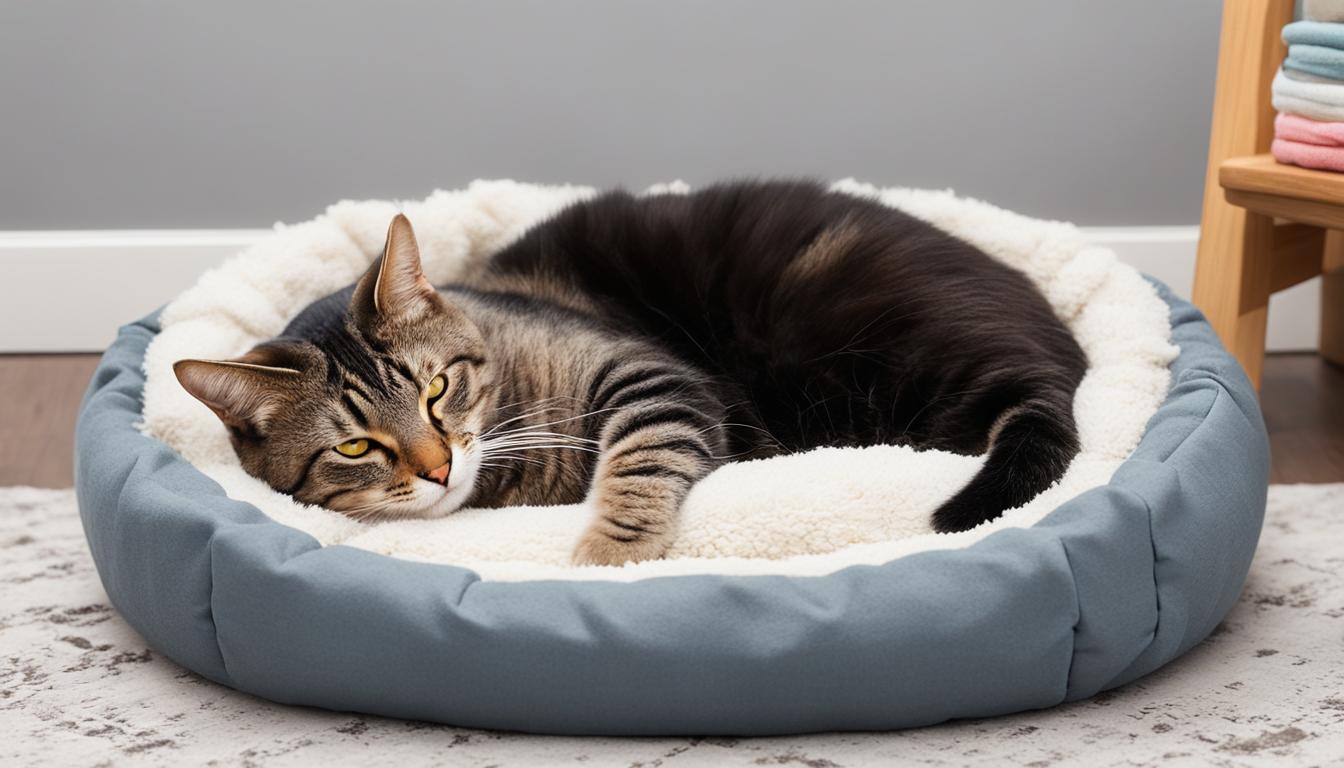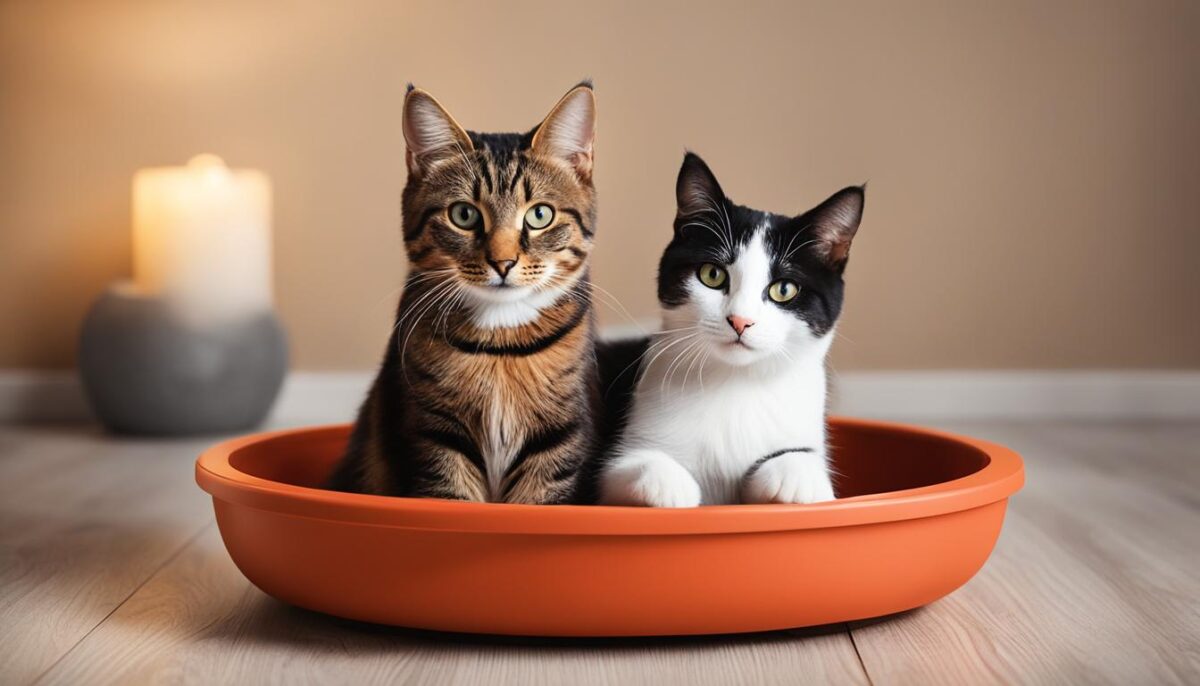If you have more than one cat at home, you might think it is a lot of fun. But they may not always be happy together and can start to fight. Have you added a new cat to your family? Your first cat may not like this as much as you do. Cats need their own time to become friends. They can take months or maybe even a year to feel like part of the team. Some cats like hanging out with other cats, and some like to be on their own. It’s not about how old they are or if they are boys or girls. It’s all about how each cat is on the inside.
It’s important to **prevent cat fights** to keep the **feline harmony**. And guess what? You can help them with this. Yes, you! **Cat behavior management** is something you can do to make a happy home for all your cats. Ready to find out how? Let’s go!
Key Takeaways
- Cats need their own space and time to be friends.
- It’s all about the cat’s personality, not age or gender.
- Helping your cats get along means a happier home.
- You can learn how to prevent fights between your furry friends.
- Remember, you play a big role in your cats’ friendship.
Recognizing Cat Conflicts
When your cats are together, you may see them playing or maybe looking a bit mad at each other. Sometimes, it’s all just fun, but other times, they may actually be upset. Knowing if your cats are play fighting or really getting into a fight helps you keep them safe and happy.
The Difference Between Playful and Aggressive Behavior
Cat play fighting is normal and good for cats. It’s how they learn and have fun. When cats are play fighting, they might chase each other, roll around, and gently bat their paws. It can look like dancing where no one gets hurt. They keep their claws in and don’t make loud noises. They’re just having a good time!
Signs of a Real Cat Fight
If the fun stops and you see cat aggression signs, your cats may be in a real fight. Look out for loud hissing, screeching, or if they start to hurt each other. After real fights, cats might not want to be around each other. They may even get scratches or scars. Something else to watch is if they don’t let each other walk around the house or use the kitty litter. That’s a big no-no and means they’re not happy with each other.
Understanding Silent Aggression in Cats
Silent cat aggression can be sneaky because it’s tough to spot. It’s like when one cat blocks the other from something they want without making noise. If one cat is always taking the best sleeping spot or not letting the other near the food, that’s this kind of mean move. They might not fight with claws or loud sounds, but it’s still a sign they are not happy or feeling friendly.
Preparing for Peace: Introducing New Cats
When you bring a new cat home, it’s like making a new friend. Think about how you feel when you meet someone new. Your cat feels the same way! They need a bit of time to know everything is okay. You can help by creating a special new cat introduction room. Put a comfy bed, some toys, food, and a litter box in there. It’s like their own little house!
Did you know cats can talk with smells? They smell each other to say “hello”. So, giving them time to smell each other from different rooms is a smart move for cat acclimation. It’s like sending letters before meeting!
Food makes everyone happy, right? Cats too! Giving treats near the door that separates your new cat from your other pets can make them want to be friends. It’s like saying, “Hey, you’re cool” but with snacks.
Next, you can let them peek at each other. Maybe crack open the door a tiny bit. If they look calm and don’t puff up or hiss, that’s a good sign! They may be ready to hang out more. But remember, you should be there like a referee to make sure everyone plays nice.
Here’s a cool list that can help you with your feline introductions:
- Create a safe room for the new cat with all its needs.
- Let the cats smell each other with a door in between.
- Offer treats near the door to connect happy feelings with each other.
- Try short visits with the door open just a little.
- Always watch your cats when they’re together at first.
Remember, it’s all about taking tiny steps for a big, happy family. With your help, your cats can have a furry-tale friendship!
Creating a Harmonious Environment
When you live with more than one furry friend, you want them to be happy and get along. It’s important to make sure they have everything they need so they don’t squabble over stuff.
Managing Resources to Minimize Competition
Cats like having their own things, which makes cat resource management a big help in stopping fights. If each cat has their own food and water bowls, they’re less likely to argue. How about giving each kitty their own little dining area? That way, each feline feels special and there’s no mealtime meowing match.
Ensuring Adequate Personal Space for Each Cat
Think about when you want your own space to chill out, well, cats are the same! They need their personal space for cats. When they have their own favorite spot to nap or just look out the window, they’re going to be way happier. And happy cats mean less hissing and more purring.
Importance of Vertical and Hiding Spaces
Cats really love to climb and hide, it’s like a fun game for them. This is why cat vertical space is so cool. They can leap up onto shelves or climb up cat trees, and look down on their kingdom. Don’t forget to give them cozy hiding spots too, like a box or a little cubby hole, where they can sneak away for a snooze or just some quiet time.
How to Stop Cats from Fighting
When your furry friends start to spat, it’s important to stop cat fights quickly so no one gets hurt. Sometimes, a short break apart can turn their hisses back into purrs. Later, when you slowly reintroduce them, it’s like they’re getting a second chance to be friends.
Effective Separation and Controlled Introduction
Just like people, cats need time apart if they’re not getting along. Use a baby gate or a cracked door to let them check each other out without the tumbles and growls. This lets them be near each other without a fight.
Utilizing Calming Products and Techniques
Did you know there are special toys and scents to help cats chill out? It’s true! Feline calming products like diffusers or sprays can make your cats feel calm and cozy around each other. These can be helpful when cats need to get used to being friends.
Learning the Correct Way to Interrupt Cat Fights
When a cat tiff happens, it’s smart to distract them with a loud sound or a squirt of water. But remember to never use your hands for a cat fight intervention. Hands are for pets and treats, not breaking up a kitty kerfuffle.
If your cats need more help being pals, a vet or a cat expert might know just the thing. They might say to try out things like Soft Paws® to keep their claws safe during play. Here’s a table to check out some more things that might help:
| Product | How It Helps | How To Use |
|---|---|---|
| Calming Diffuser | Release soothing scents | Plug in the room where cats hang out |
| Soft Paws® | Covers claws to prevent scratches | Put them on your cat’s claws |
| Comforting Toys | Provides distraction and play | Spread around the house for cats to find |
Conclusion
Having cats live together can be super fun! When they are friends, everything is better. To help your cats live happily, give them lots of room. They like to have their own toys and places to go to the bathroom. They also love to relax in high spots where they can look around and feel safe. This helps keep a peaceful home with no cat fights.
If you see your cats are not getting along, try to give them their own special spots in the house. Sometimes, they need their own space to be happy. If things don’t get better, you might need to find one cat a new home where they can be happy alone. It’s important that your cats feel they have everything they need. This makes them feel safe and stops them from fighting.
Remember, the goal is harmonious cat cohabitation and feline relationship building. By keeping an eye on your cats and how they live together, you are helping them have a better life. You can do a great job maintaining cat peace with some care and understanding of what your furry friends need.
FAQ
How can I tell if my cats are play fighting or truly being aggressive?
Play fighting among cats is usually quiet and doesn’t involve claws. Look for light batting, chasing, and rolling around. Aggressive behavior involves hissing, loud noises, and the potential for injury. Watch for signs of real aggression like fur flying, intense staring, and avoiding each other after the altercation.
What are the signs that my cats are in a real fight and not just playing?
Real fights between cats will have more serious indicators such as hissing, growling, loud screeching, biting, and scratching. You may notice physical signs like scars or injuries, as well as behavioral changes like one cat blocking the other’s access to areas of the house, including the litter box.
How should I introduce a new cat to my resident cat to prevent conflicts?
Introduce your new cat gradually to your current cat. Start by giving the new cat its own space where it can feel secure, complete with food, water, a litter box, and toys. Swap their bedding or toys to get them accustomed to each other’s scent. Slow introductions through a barrier like a baby gate and supervised interaction help in reducing the tension and building feline introductions successfully.
What steps can I take to create a peaceful environment for multiple cats?
Reduce competition by providing multiple food and water stations, offering several litter boxes and ensuring enough personal space for cats to retreat. Incorporate vertical spaces like cat trees, shelves, or window perches and hiding spots to help every cat feel secure. This fosters feline harmony through proper cat resource management and respecting their need for personal space.
What should I do if my cats start fighting?
Immediately separate them into different rooms to prevent further escalation. Allow some time for them to calm down before reintroducing them in a controlled environment. Supervise their interactions, use a barrier if needed, and be ready to distract them with a loud noise or a squirt of water if they begin to fight. Consistently utilize calming products like pheromone diffusers or sprays which may facilitate peaceful behavior and prevent cat fights.
Are there specific calming products that can help maintain peace between my cats?
Yes, there are several feline calming products available, such as pheromone diffusers, sprays, and collars, which release chemicals that mimic the natural calming pheromones of cats. There are also supplements and treats formulated with ingredients known to support calmness. Calming toys and environmental enrichment activities can also help reduce stress and tension between cats.
Is there a correct way to break up a cat fight?
Yes, safe intervention is crucial. Avoid using your hands to separate fighting cats as this could result in injury to you or the cats. Instead, make a loud noise to startle and distract them, or use a spray of water. Once the cats are distracted and separated, place them in different rooms to cool down before attempting any reintroduction.


